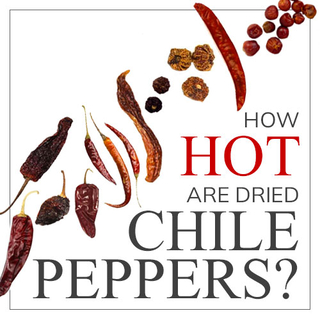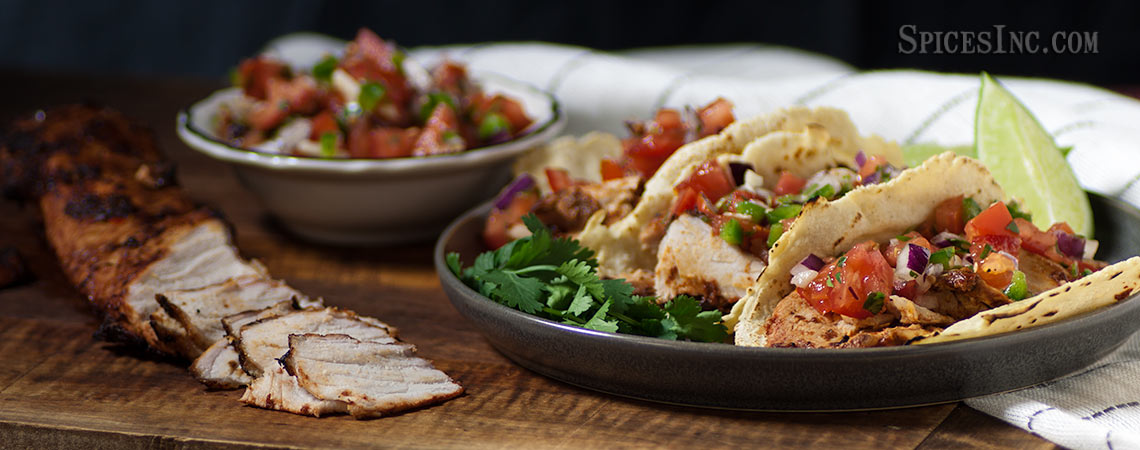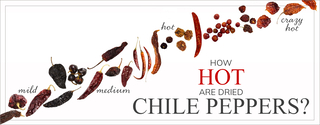How Hot are Dried Chile Peppers?

Chile peppers encompass an enormous range of heat; the Carolina Reaper is searingly hot, measuring between 1,400,000 - 2,200,000 Scoville Heat Units (SHU). When you're looking for which dried chiles are the hottest, the Scorpion Chile, measures between 500,000-1,400,000 SHU, and was the hottest dried chile in the world until it was unseated by the Reaper. On the other end of the heat scale sits the familiar and friendly Bell Pepper, which contains zero heat. For perspective, a standard jalapeño chile, with which most of us are familiar, has a heat score of 8,000. There is a pepper that’s hotter than the Carolina Reaper; the Dragon’s Breath chile clocks in with an astounding heat score of 2.4 million Scoville Heat Units, but the Dragon’s Breath was developed for use as an anesthetic and is not available for consumption.
Heat levels are fluid in peppers and can cover a large range of SHU, even among individual varieties. A rainy growing season tends to produce milder peppers, while a dry season makes them hotter. A warm-weather region often produces hotter peppers, particularly if the nights stay warm as well. High concentrations of nitrogen in the soil also encourage capsaicin production so it makes the pepper hotter—and as a bonus, using a higher-nitrogen fertilizer also tends to increase a plant’s yield, so you get more peppers overall.
But what does this score mean? Where does this heat come from? How do we measure a chile pepper’s heat? Chiles are measured on the Scoville Scale. In 1912 Wilbur Scoville, a pharmacist devised a test to define the pungency of a pepper’s heat. Capsaicin is the chemical irritant that lives in the membranes, white pith, and seeds of a pepper and is responsible for the spicy kick. An extract from a particular pepper is diluted in water until it overwhelms the capsaicin and no heat is tasted. Larger amounts of water to achieve 0 heat means it has more Scoville Heat Units, or SHU. The Scoville Scale is normally viewed as an 11-part chart that shows the highest heat at the top and the lowest heat at the bottom. The bottom of the scale is 0-100 SHU, and features peppers like the Bell or the sweet Pimiento. Ten sections up sits the peppers that measure between 1,500,000 and 3,000,000 SHU, like the Carolina Reaper. We have an internal pepper scale with much less specific delineations; our chile peppers are grouped by whether they are Mild, Medium, Hot, or Crazy Hot. While our groupings are less specific, we’ve found in talking to customers that they can relate to these descriptions much more readily than they can to a strictly numerical breakdown.
Chile pepper heat charts use graphics to tell their story, and often show hotter pepper ranges in increasingly intense shades of red to mirror the idea that red peppers are the most fiery peppers available. It’s a common misperception. Red peppers are just more ripe and mature than their green counterparts. And in some cases, like in the instance of jalapeños, the red, mature version of the pepper is often a touch milder than its green counterpart, since the growth energy of the plant goes into sweetening the pepper rather than increasing the heat. A green Ghost Pepper, no matter how docile and green it may look, still measures at more than 1,000,000 SHU. Approach peppers with caution! Looks can be deceiving.
Table of Contents
Dried Pepper Heat Chart
There can be a lot of confusion regarding hot chiles and just what, exactly, they are. Part of that comes from the fact that the same chile pepper when fresh can be called something else when dried. A fresh, green jalapeño pepper, when it’s dried and lightly smoked, becomes a chipotle morita, which is the chipotle most of us are familiar with. When it’s dried under heavy smoke, it becomes a chipotle meco.
In many of our conversations with customers, we’ve come to realize that the best way to group chile peppers isn’t by a listing of numbers that may seem arbitrary, but rather, by groupings which help put Scoville evaluations into perspective. Hence we’ve developed the Mild/Medium/Hot/Crazy Hot scale, which helps explain what a heat score actually means.
Red chile peppers are primarily the ones selected for drying, since they are at their most ripe and can deliver the most flavor and nuance to a dish, though some peppers are more orange at peak ripeness. Lighter colored peppers do not mean they’re not as ripe, nor does it mean they’re not as spicy. Depending on the maturation or a pepper or the processes used during drying, chiles can look dusty and brown or almost purple-black. These differences in color are all trademarks of unique flavor characteristics of the peppers, so in the long run it’s helpful to understand the differences in physical appearances. Keep chile peppers whole if you want to simmer them for a long period of time in stock or cream, or break them down into chile flakes for a punch of terrific flavor right at the end of cooking time.

Mild Dried Chiles
Aji Paprika chile – 120-140 SHU. Mild and sweet, with plummy stone fruit flavors and a touch of smoke.
Choricero chile – 175-300 SHU. Fruity and bittersweet, with elements of cherries and rich sun-dried tomatoes.
Dried Nora chile – 500 SHU. Sweet and earthy.
Anaheim chile – 500-1000 SHU. Pungent, grassy, and slightly sweet.
Aji Panca chile – 500-1500 SHU. Berry-like flavor with aromatic, smoky taste.
Ancho chile – 1,000-1,500 SHU. A mild fruity flavor with undertones of plum, raisin, tobacco and a slightly earthy bitterness.
Hatch New Mexico chile – 800-1,400 SHU. Earthy, sweet flavor with hints of acidity and dried cherry undertones.
Organic Anaheim chile – 900-1200 SHU. Grassy and fresh with a touch of sweetness.
Pasilla Negro chile – 1,000-1,500 SHU. Pungent and tangy with chocolate and raisin notes, a rich flavor and woodsy undertones.
Mulato chile – 1,000-1,500 SHU. Sweet flavor with hints of smoky chocolate, licorice, cherries, and coffee.
Cascabel chile – 1,000-2500 SHU. Mild fruitiness with undertones of plum, raisin, tobacco and an earthy bitterness.
Organic New Mexico chile – 1,000-2,000 SHU. Earthy, sweet flavor with hints of acidity and dried cherry undertones.
Kashmiri Chile – 1,500-2,000 SHU. Mild, sweet, and fruity.
Organic Pasilla Negro chile – 3,000-4,000 SHU. This chile is pungent and sophisticated, with notes of chocolate and raisins and rich, woodsy undertones.

Medium Dried Chiles
Guajillo chiles – 2,500-5,000 SHU. Slightly fruity with a sweet heat, tannic with a hint of pine, tart berries and light smoky undertones.
Chipotle Meco chile – 2,500-10,000 SHU. Deeply smoky with hints of grassy fruitiness.
Chipotle Morita chile – 2,500-10,000 SHU. Fruity and smoky, with touches of chocolate.
Puya chile –5,000-10,000 SHU. A light and fruity flavor profile with licorice and cherry undertones.
Costeno Rojo chile – 5,000-15,000 SHU. Nutty and complex with fruity notes, green, soapy undertones and an intense, lingering heat.
Calabrian chile – 5,000-25,000 SHU. Berry-fruit forward flavor with a deep and resinous back note and a touch of smoke.
Smoked Red Serrano chile – 8,000-18,000 SHU. Crisp, smoky, fruity flavor with citrus undertones.
Tien Tsin chile – 10,000-60,000 SHU. Musty and pungent, with a snappy, peppery aroma.

Hot Dried Chiles
Pasilla de Oaxaca chile – 15,000-20,000 SHU. A sharp, smoky flavor with hints of tobacco and a biting heat that lingers.
Japones chile – 15,000-30,000 SHU. Clean taste that’s all about the heat.
De Arbol – 15,000-30,000 SHU. A grassy flavor with a hint of nuttiness and a searing, acidic heat.
Organic Chipotle Morita chile – 15,000-30,000 SHU. Deep berry fruit and hints of smokiness, with a raisin and chocolate finish.
Criolla Sella chile – 20,000-30,000 SHU. Juicy and sweet with touches of citrus and mango, and a deep molasses-like flavor.
Guntur Sannam chile – 25,000-35,000 SHU. Cherry fruitiness at first, followed by mellow tobacco and smoke.
Aji Amarillo chile – 30,000-50,000 SHU. Full-bodied flavor that’s reminiscent of raisins and passionfruit.
Pequin chile – 30,000-60,000 SHU. Earthy flavor with hints of roasted peanuts.
Wiri Wiri chile – 60,000-80,000 SHU. Subtle, rich fruitiness with an aroma that hints of chai and teriyaki.

Crazy Hot Dried Chiles
Chiltepin chiles – 50,000-100,000 SHU. Smoky and earthy with up-front heat.
Thai Bird chiles – 70,000-130,000 SHU. Bold, peppery heat with deep berry flavors and a hint of nuttiness.
African Bird’s Eye chiles – 100,000-225,000 SHU. Dry, hay-like flavor and a clean, burning heat.
Malagueta chiles – 120,000-160,000 SHU. Bold, brash, clean burst of initial heat that fades into an earthy, almost tomato-like sweetness.
Habanero chiles – 100,000-350,000 SHU. Tropical fruit flavors of coconut and papaya, with berry undertones and an acidic and intense fiery heat.
Scotch Bonnet chiles – 200,000-300,000 SHU. Fruity with bright apple and cherry highlights and a rich, tomato-like depth.
Scorpion chiles – 500,000-1,400,000 SHU. Short-lived fruitiness gives way to a blast of clean heat that lingers.
Ghost chiles – 1,000,000+ SHU. SO. MUCH. HEAT. There are echoes of tropical fruit and a bit of smoke, but this pepper is all about the heat.
Where To Buy Dried Chile Peppers?
The demand for chile peppers has risen significantly since the 1980s, with per-capita consumption increasing by 135%1. Back then, peppers were largely available only in specialty markets that carried international produce and supplies, though you should be aware that small markets may not move their products quickly or rotate chiles to make sure their stock is being presented in a timely fashion. These kinds of markets are still an option, but you can also find an increasingly broad selection of chile peppers in your local grocery store. Try searching for them near the fresh produce, or in the sections of your supermarket where you can purchase Mexican or Asian foods. Look for stores that have a steady customer flow, since peppers will be less likely to sit on the shelves in places where people are shopping. And look for peppers that are pliable; if they are too brittle or dry, they will be inferior in quality. While there’s a decided ease with one-stop shopping and getting your chiles in a grocery store, there’s a downside. Employees, from the buyers to the store clerks, are often not trained in the nuances of different dried chiles, some of which can look similar and are easily mislabeled en route along the sales chain.
While chile peppers are easier to find in brick-and-mortar stores, both popular and less in-demand chiles can be sourced from online retailers. Again, look for companies that have a high turnover in their products and, it’s a bonus if the online retailers are transparent about when and from where they got their products. Since you can’t physically be in an online store, look to both on- and off-site reviews to see what their online customers are saying about them, and if you find their service doesn’t meet your expectations, rest assured that there are other retailers to shop with. Here at Spices, Inc. we offer the largest selection of dried chiles and chile products on the web, and have multiple team members that specialize in every step of our chile pepper sourcing, receiving, storage and shipping processes to ensure that the peppers we send out are of the highest quality.
Are Dried Chiles Hotter Than Fresh?
So can you substitute fresh chiles for dried ones, or vice-versa? It’s tempting to say yes, but in all practicality, the answer is no. Once a pepper dries it becomes a completely different fruit than it was when it was fresh. The texture is thinner and lacks any sort of crunch or crispness. You can rehydrate a chile pepper but it won’t restore it to its original texture, it will only make it more pliable and easier to cut. And capsaicin isn’t the only thing in the pepper to concentrate. Sugars will concentrate, as well as the hidden flavor components buried deep in a spicy chile, so the more subtle flavors emerge. Often dried peppers are said to taste of chocolate, or plum, or have rich tropical nuances that the fresh versions just can’t deliver. The best approach is to use each pepper in the form a recipe asks for; if it wants a dried chile pepper, then that’s what you should use.

Chile Marinated Pork, Oaxaca-Style, is a terrific dish that allows you to experience the range of flavors, like sweet berry notes and deep smoky flavors, that come from dried chile peppers.
1. Lillywhite, J.; Tso, S. Consumers within the Spicy Pepper Supply Chain. Agronomy 2021, 11, 2040. Retrieved March 23, 2022.

